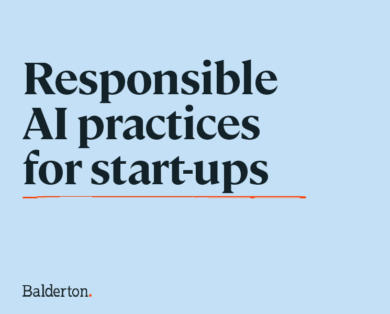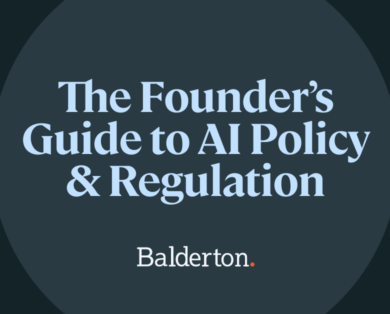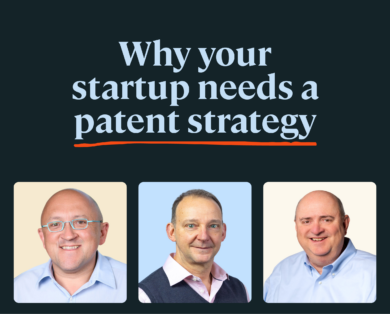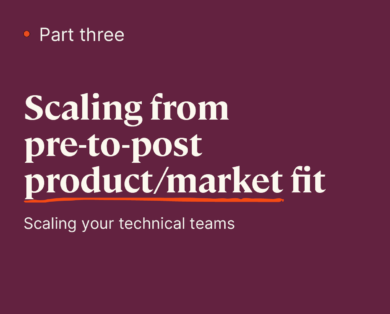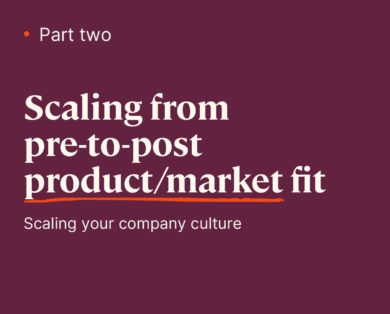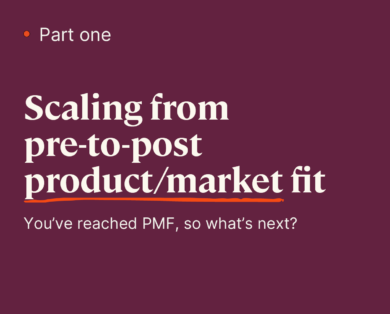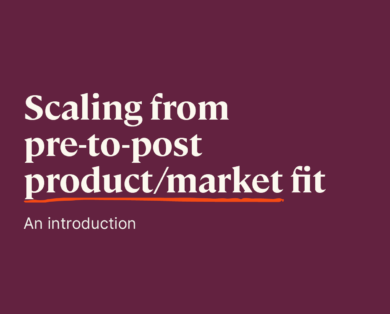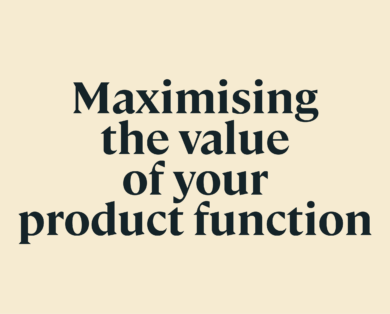- 15 January, 2025
In the journey from pre- to post-Product/Market Fit (PMF), the transformation of the Product organisation is as critical as the evolution of the Engineering team.
This transition requires a shift from a largely exploratory and founder-driven approach to a more structured, customer-centric strategy that can scale.
Set clear direction amidst growth
The necessity for clarity in direction becomes paramount as your company grows, since the cost of ambiguity scales exponentially with the number of people.
In the past, when you were a smaller company, ambiguity would be removed quickly at the coffee machine with the rest of the team overhearing. In a larger organisation, you can’t rely on informal communication and escalation, you need to now be deliberate about setting, communicating, steering and correcting direction. Specifically, you need to think about the following.
Clear mission and vision: everyone in the company needs to be aligned around the mission and vision of your organisation, basically answering the questions “what are you trying to solve” and “what will success look like”. Similar to what we discussed in Part 2 for company values, mission and vision should inform all day-to-day decisions made by your teams. Ideally, mission and vision should mostly come from the founders. Having endless discussions about how to word these is a sign of a lack of clarity on what your company should be doing.
Integrated product and business strategy: a clear product strategy is a means to disambiguate but is often considered something separate from your business strategy. In our experience, they largely overlap and no product strategy can be defined without a clear business strategy (see here for argumentation for this and a minimal framework). In fact, “strategy” should be owned by Product and not be a separate function.
Investment attribution and impact: the better you can measure the impact of your investments of people, time and money in product development, the faster you will grow. Whereas in the past (pre-PMF) you would care about hitting milestones, when scaling you want to as objectively as possible assess the impact of your product investment on the business.
Accurate attribution of impact to investments is actually non-trivial but starts with making sure you are not changing your product in ways that are negative for growth without knowing it. A/B testing and other techniques may now be in reach to assess the impact at least at an individual experiment level. This will prevent you from hurting your product with changes that are bad – which are most of the changes!
Accelerate learning through focus
The main objective of a product development organisation is to learn as fast as possible what the main drivers are for customer value and what changes capture that value. Because industry data shows most things don’t work, you will have to try a lot as fast as possible. Kiss a lot of frogs!
The essence of scaling post-PMF lies in accelerating your company’s learning curve – identifying what truly drives customer value and doubling down on those insights. The factors that enable this acceleration are discussed below.
Understand the fundamentals: you need to develop a keen understanding of the job(s) to be done and what really matters for your customers (a.k.a. the “fundamentals”). Once you have that understanding, you can formalise the fundamentals in metrics; these metrics should be the primary ones you optimise.
As an example, consider Google search, which from its inception was driven by two fundamentals: relevance and speed. These are indeed the things that matter the most to search users; many of the decisions early on at Google were based on these criteria. Other search engines did not pay sufficient attention to these metrics, and either fell by the wayside or were never able to seriously challenge Google’s dominance.
Roadmap clarity: define a clear roadmap tightly connected to your product strategy. In the end, everything in there has to align with and support the company strategy. How much into the future should the roadmap extend? It depends on how fast your vertical is moving. For instance, at Criteo, Product would develop each quarter a 9-month plan, which would be quite detailed for the coming quarter (this was needed for OKR setting) and more high-level/directional for the subsequent 6 months.
Simplifying goal-setting: choose and commit to a single goal-setting mechanism, and don’t overcomplicate – many companies have forced quite a complex mechanism on themselves by trying to implement OKRs by the book – but also many other companies are not reaping the benefits of OKRs because they follow the least effort implementation. Stay away from complexity in goal-setting frameworks, if you can do with simple, measurable targets you may want to stick with that.
Portfolio management: define your product portfolio, and make explicit what is optimization and what is innovation, as these efforts differ fundamentally in approach, risk profile, and profile of people you need to be successful.
Minimise work in progress: be paranoid about the amount of work in process as each extra unit of work in progress creates exponentially more overhead, dependencies that need to be managed, and confusion. This is especially hard to do as you have achieved PMF and everyone has thousands of ideas.
Prioritisation: establish an agreed approach to prioritisation that in a structured way brings the ideas with the most potential to the top of the list and focuses on validating those ideas as fast as possible. There are various frameworks for prioritisation but key dimensions to consider are potential value, ability to objectively assess value, feasibility, cost to build, scalability, and confidence level.
Product intuition remains critical: note that ideas (hypotheses) on the next most valuable thing to do can come from anywhere, and are typically the result of qualitative research, quantitative analysis, and market research. The best product managers are by definition those who with the least amount of time and effort spent in hypothesis development (discovery) identify the most valuable hypothesis – this is where strong product intuition comes in and can make a significant difference in how fast the company evolves its proposition.
You’re not operating in a vacuum: your Product team needs to be keenly aware of competitive products, table stakes and differentiators. Table stakes you can copy, differentiators are by definition your own. Note however that too much of a focus on differentiators can sometimes be counter-productive: many companies fail because they don’t focus enough on the fundamentals and get distracted by the siren call of differentiation.
Build the right team to scale
As your Product team grows, aligning its composition with the evolving needs of the business becomes crucial. This involves both cultivating internal talent and attracting new, high-calibre individuals who can bring fresh perspectives and elevate the team’s overall performance.
How large of a Product team? In general, a ratio that seems to work is about 1 PM to 8-10 developers. Having too many PMs can become counterproductive: if they can generate more work than the development team can absorb, this will lead to countless prioritisation and resource allocation discussions. As mentioned in Part 3, keeping the PM team slightly understaffed may help focus on the real priorities.
Hire for tomorrow: bringing in external talent should aim to raise the bar, adhering to the principle that A players attract A players. The focus should be on hiring individuals who not only fit the current culture but also bring the skills and experience needed for the company’s next stage of growth.
If you don’t have them on your team yet, It may be useful at this stage to bring in a few senior Product Managers who have the experience of working in a company with a strong Product discipline (see next section). Make sure that these senior hires have actually delivered a solid product, preferably through multiple versions/iterations (i.e. they “walk the walk”). You want to hire PMs who are doers, since “pure thinkers” will have little (positive) impact in practice.
Balance agility with structure
Adapting your processes to the growing scale of the organisation while maintaining agility is a delicate balance. Processes should facilitate rapid learning and decision-making without becoming a burden.
You need to start building a proper product discipline at this point. At a minimum, this needs to cover market and customer research, strategy, requirement definition and prioritisation, experimentation, data-driven focus, User Experience (UX), and analytical skills. These are multiple aspects of several different role types, i.e. you may build a team of generalist PMs, Product Analysts, UX Researchers and Designers.
Methodology: embrace a hypothesise-build-test-learn cycle, making it the core of your product development process. This rigorous approach ensures that decisions are data-driven and that the organisation remains focused on learning and adapting.
Process Minimization: keep processes as lightweight as possible, introducing structure only where it adds clear value. Overly cumbersome processes can stifle innovation and slow down execution. If you find yourself introducing a lot of processes you may need to set a higher bar in hiring and/or hire more experienced people.
Cost of Change: change becomes exponentially more difficult and expensive with scale, keep things simple as much as possible and when changing bias towards evolutionary change versus revolutionary change.
Design your Product org for scalability
Designing an organisation that can scale involves thoughtful decentralisation, specialisation, and a commitment to maintaining a flat hierarchy as much as possible.
Decentralisation: decentralise where possible to prevent endless resource allocation debates. E.g. assign some Product bandwidth to Marketing as fixed resource capacity which Marketing directly controls.
Specialisation: as the Product team grows, specialisation allows for deeper focus and expertise in areas like UX research, data analysis, and specific product domains such as ML or technical platforms. This also allows for breaking out responsibilities that may have been originally in the scope of Product Managers so they can focus more on hypothesis development and the quality of the work as a whole improves – the downside is more hand-overs and potential bottleneck creation – balance this well by not having any function exclusively own any part of what is typically in the early stages of a company in the Product Manager’s scope.
Shifting the focus from delivery to hypothesis development: in the pre-PMF stages, PMs often operate based on directives from the founders, prioritising rapid execution and delivery. However, after achieving PMF, the emphasis for PMs must pivot towards aggressively generating and testing new hypotheses about what could drive the most value for the customers. This shift is crucial as the founders increasingly divert their focus to overarching company management, leaving a gap in direct product innovation. By dedicating PMs primarily to the exploration and validation of new ideas, rather than the management of delivery processes, your organisation can significantly increase the volume and variety of potential value-driving initiatives. This strategic realignment allows for quicker identification and capitalization on opportunities, positioning your company to outpace competitors in value creation and innovation.
Optimization vs. innovation: distinguishing between optimization and innovation is crucial for aligning your team’s capabilities with your strategic objectives. For optimization efforts, a new type of activity post-PMF involves refining and improving existing products or processes; you need individuals who excel in analytical thinking, attention to detail, and process improvement. These talents are pivotal for making incremental changes that enhance performance and user satisfaction.
Conversely, innovation requires a different set of skills – creative problem-solving, a willingness to embrace risk, and the ability to think outside the box. These individuals are adept at identifying new opportunities and driving the development of novel products or services. (As mentioned earlier, the most effective innovation may be the one that focuses more on the fundamentals rather than the differentiators.)
Effectively managing these two areas means recognizing that the skill sets and mindsets for optimization and innovation are distinct, and each requires a tailored approach to leadership and project management.
Org structure adaptation: regularly review and adjust the org structure to ensure it remains aligned with customer needs and business objectives. This includes preventing the siloing of new functions and maintaining a culture that prioritises customer value above internal processes. Prevent the product from becoming a reflection of your organisation (cf. Conway’s law).
Keep it flat: maintaining a flat org structure promotes agility and quick decision-making, enabling faster adaptation to market changes. It encourages open communication and collaboration, allowing ideas to flow freely and reducing bureaucracy. This approach enhances employee satisfaction by giving everyone a voice and fostering a sense of ownership across projects. Keeping the hierarchy flat is key to fostering an innovative and responsive work environment.
Cap the cost of bureaucracy: prevent new functions outside the Product org from introducing process and bureaucracy, by setting a budget for time that people can spend on stuff that doesn’t help customers – otherwise you will see functions like HR, Legal, Security, Risk independently – as the company grows – put a tax on the time people can spend on customers, with all best intentions but with no incentive to be highly critical of that tradeoff: time on us or time on customers.
In Part 5 we will dive into the specifics of scaling Engineering teams.

